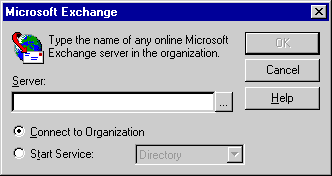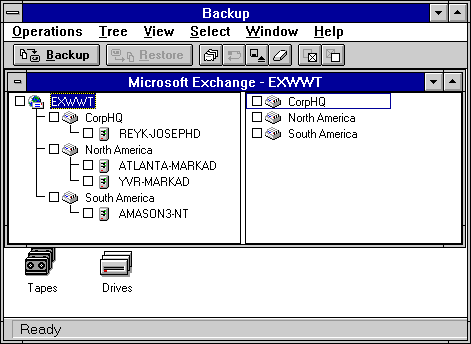
| Maintenance and Troubleshooting | << | >> |
|---|
You can back up a server to any tape device compatible with Windows NT Server. The tape drive must be directly connected to the computer running the Backup program, but the server you are backing up can be anywhere on the network.
Note To back up configuration settings that may not be recorded in the directory, you can use the Backup program to back up the registry on the Microsoft Exchange Server computer. For more information, see your Windows NT documentation.
You can perform an online or offline backup of Microsoft Exchange Server directory and information store databases. However, it is recommended that you perform only online backups to minimize system downtime.


To perform an offline backup of a Microsoft Exchange Server database, you must stop the service you're backing up and then back up individual databases.
The following table shows the Microsoft Exchange Server database files and default directories.
| Component | File | Directory |
|---|---|---|
| Directory | Dir.edb | Exchsrvr\Dsadata |
| Private information store | Priv.edb | Exchsrvr\Mdbdata |
| Public information store | Pub.edb | Exchsrvr\Mdbdata |
| Microsoft Mail directory synchronization | Xdir.edb | Exchsvr\Dxadata |
| KM Server | Kmsmdb.edb | Exchsrvr\Kmsdata |
Note The directory and information store database directories on your server may be different from those listed in the preceding section if you changed them using Performance Optimizer or using the Database Paths property page on the server object.
You can use the At.exe utility provided with Windows NT to schedule times when backups are automatically performed. This utility can also be used to schedule a backup on another Microsoft Exchange Server computer.
You can create a command-line batch file to back up Microsoft Exchange Server components. For more information, see your Windows NT documentation.
The following parameter enables command-line backups of the Microsoft Exchange Server databases:
path
If you are backing up Microsoft Exchange Server components, specifies the component and the server using the following format:
{DS server | IS server}
Where server is the name of the server you are backing up preceded by two backslashes (for example, \\berkeley). DS indicates that you are backing up the directory, and IS indicates that you are backing up the information store. For example, to back up the information store, use IS \\berkeley.
The following example would back up the directory and information store on Server_A and the directory on Server_B, validate the backup (/v), using a normal backup type (\t:normal).
Ntbackup backup DS \\Server_A IS \\Server_A DS \\Server_B /v \t:normal
To ensure that your information store is being backed up correctly and no information is lost, restore a server from tape backup to another nonproduction server and verify that you can log on to mailboxes and public folders on the restored server.